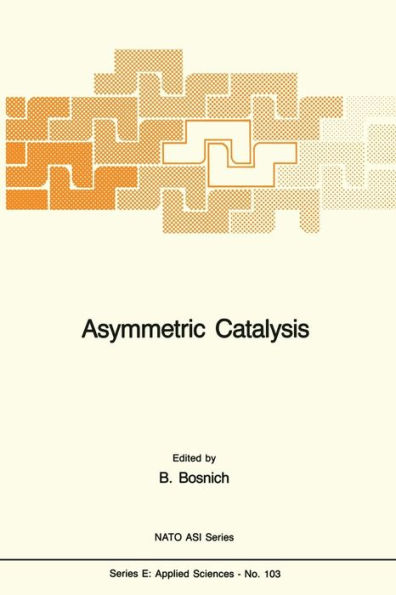5
1


Paperback(1986)
$54.99
-
PICK UP IN STORECheck Availability at Nearby Stores
Available within 2 business hours
Related collections and offers
54.99
In Stock
Overview
The rate of advance in areas of science is seldom constant. Usually certain fields effloresce with activity because of the ~ealization that solutions are possible to long standing important problems. So it is now with asymmetric catalysis, a field which promises to change profoundly the strategic thinking of synthetic chemists. As this Report will show, reagents which can induce catalytic enantiocontrol of chemical transformations could represent the ultimate synthetic method. Nearly all synthetic strategies of complex molecules involve steps which require enantiocontrol and, in many cases, a specific catalytic transformation embodying enan tiocontrol has enormous advantages in terms of the rate and economy of the reaction. Because asymmetric catalysis is in a formative stage, workers with different backgrounds have joined the field. This Workshop had representatives with organometallic, organic, structural, kinetic, enzymatic, microbiological and industrial backgrounds. Each had his own perspective and this Report represents a consensus of this group of eleven people. The result is probably as comprehensive and balanced a view of the subject as is possible at present. It is hoped that those who have until now had but a glancing interest in asymmetric catalysis will find this Report a useful indication of its present state. We believe that asymmetric catalysis will have an increasing impact on the development of chemistry and will eventually dominate much of synthetic and industrial chemistry.

Product Details
| ISBN-13: | 9789401087919 |
|---|---|
| Publisher: | Springer Netherlands |
| Publication date: | 09/26/2011 |
| Series: | NATO Science Series E: , #103 |
| Edition description: | 1986 |
| Pages: | 172 |
| Product dimensions: | 6.10(w) x 9.25(h) x 0.01(d) |
Table of Contents
1 - General Principles.- 1. Catalysis.- 2. Turnover Limiting Step.- 3. Origin of Catalysis.- 4. Catalytic Cycles.- 5. Classification of Catalysts.- 6. Asymmetric Synthesis.- 7. Asymmetric Discrimination.- 8. Reactant Control and Product Control in the Enantio- selective Step.- References.- 2 - Carbon-Hydrogen Bond Formation.- 1. Asymmetric Catalytic Hydrogenation.- References.- 2. Asymmetric Hydrogenation of Ketones.- References.- 3. Asymmetric Double Bond Migration.- References.- 4. Asymmetric Hydrosilation.- References.- 3 - Carbon-Carbon Bond Formation.- 1. Hydroformylation.- References.- 2. Asymmetric Hydrocarboxylation.- References.- 3. Asymmetric Hydrocyanation.- References.- 4. Asymmetric Allylic Alkylation.- References.- 5. Asymmetric Grignard Cross-Coupling.- References.- 6. Asymmetric Cyclopropanation.- References.- 7. Catalytic Asymmetric Codimerization.- References.- 1. Catalytic Asymmetric Cyclodimerization, Skeletal Rearrangement and Telomerization and Asymmetric [3+2]-Cycloaddition.- References.- 2. Asymmetric Catalyzed Diels-Alder Reaction.- References.- 4 - Asymmetric Oxidation.- 1. Asymmetric Epoxidation.- References.- 2. Asymmetric Oxidation of Sulfides.- References.- 5 - Heterogeneous and Polymer Supported Catalysts.- 1. Impregnated Heterogeneous Catalysts.- 2. Electrochemical Asymmetric Reduction.- References.- 3. Polymer Supported Catalysts.- References.- 6 - Asymmetric Catalysis by Biochemical Systems.- (i) Classification of Enzyme Reactions.- (ii) Coenzymes.- (iii) Fermentative vs. Enzymic Processes.- (iv) Enantiotopic Group Differentiation.- (v) Immobilized Enzymes and Cells.- (vi) Range of Applicability of Enzymes.- References.- 7 - Economic Significance of Asymmetric Catalysis.- 1. Economic Advantages of Asymmetric Synthesis.- 2. Intramolecular Aldol Condensations of Hajos and Eder.- References.- 3. Potential Chirons of Economic Importance.- 4. Examples of Target Molecules which have been more Economically Prepared by Asymmetric Synthesis.- 8 - Future Trends.- 1. Enzymes and Microbes.- 2. Inorganic Systems.- 3. Purely Organic Catalysts.From the B&N Reads Blog
Page 1 of
